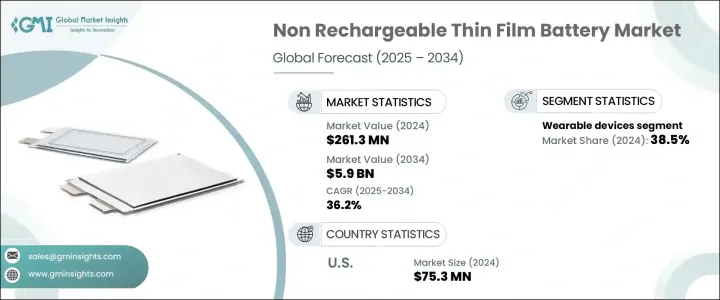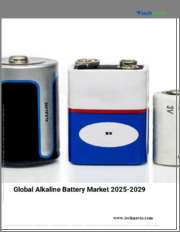
|
시장보고서
상품코드
1740929
비충전식 박막 배터리 시장 : 기회, 성장 촉진요인, 산업 동향 분석 및 예측(2025-2034년)Non Rechargeable Thin Film Battery Market Opportunity, Growth Drivers, Industry Trend Analysis, and Forecast 2025 - 2034 |
||||||
세계의 비충전식 박막 배터리 시장은 2024년에 2억 6,130만 달러로 평가되었고 차세대 전자기기에서의 콤팩트하고 효율적인 에너지 솔루션에 대한 수요 증가로 2034년에는 59억 달러에 이를 것으로 추정되며, CAGR 36.2%로 성장할 전망입니다.
기기가 점점 더 작아지고 강력해짐에 따라 가전제품, 의료용 웨어러블, IoT와 같은 산업에서 유연한 고성능 전원 공급장치의 필요성이 높아지고 있습니다. 가벼운 구조와 긴 보관 수명, 다양한 설계 적용이 가능한 비충전식 박막 배터리는 에너지 효율이나 신뢰성을 유지하면서 초소형 기기에 전원을 공급하는 데 중요한 구성 요소로 자리 잡고 있습니다.

소형화, 5G 연결성, 스마트 기기 에코시스템의 발전으로 이 시장은 강력한 견인력을 발휘하고 있습니다. 다양한 분야의 제조업체들이 전압 안정성이나 안전성에 영향을 주지 않으면서도 공격적인 폼 팩터 요구 사항을 충족하기 위해 박막 기술에 의존하고 있습니다. 환경적 지속 가능성도 중요해지면서 박막 배터리는 내구성이 뛰어나고 유지보수가 필요 없는 솔루션을 제공하여 전자 폐기물을 줄일 수 있기 때문에 기술 혁신가들에게 더욱 매력적인 선택이 되고 있습니다. 또한 박막 배터리는 더 나은 안전성, 에너지 밀도, 수명 주기 성능을 약속하는 고체 에너지 저장 시스템으로의 전환과도 잘 맞닿아 있습니다. 혁신이 제조 비용을 낮추고 확장성을 개선함에 따라 비충전식 박막 배터리 시장은 의료, 산업 자동화, 항공우주, 차세대 소비자 가제트 전반으로 더욱 확대될 것으로 보입니다.
| 시장 범위 | |
|---|---|
| 시작 연도 | 2024년 |
| 예측 연도 | 2025-2034년 |
| 시작 금액 | 2억 6,130만 달러 |
| 예측 금액 | 59억 달러 |
| CAGR | 36.2% |
건강 추적기, 디지털 보청기, 초박형 스마트워치와 같은 기기는 좁은 폼 팩터에서 안정적인 전압을 공급할 수 있기 때문에 소형 배터리에 대한 의존도가 점점 더 높아지고 있습니다. 스마트 인프라, 원격 감지 및 산업 자동화 전반에 걸쳐 IoT 배포가 빠르게 확장됨에 따라 높이가 낮고 오래 지속되며 안정적인 에너지원에 대한 필요성이 더욱 커지고 있습니다. 솔리드 스테이트 기술과의 강력한 호환성과 맞춤형 설계를 제공하는 박막 배터리는 이러한 진화하는 요구에 이상적으로 적합합니다. 고체 전해질의 획기적인 발전과 향상된 구조 기술은 배터리 성능, 신뢰성 및 생산 확장성을 더욱 향상시키고 있습니다. 개발자들은 전력 밀도와 안전 표준을 향상시키는 동시에 작동 수명을 연장하기 위해 노력하고 있습니다.
웨어러블 기기 부문은 2024년 38.5%의 점유율을 차지하며 세련되고 인체공학적인 디자인 요건을 충족하는 배터리에 대한 강력한 수요를 보여줬습니다. 유연성 덕분에 곡선형의 소형화된 소비자 웨어러블 기기에 원활하게 통합되어 건강 중심 및 라이프스타일 기기를 모두 지원할 수 있습니다. 오래 지속되고 유지보수가 필요 없는 전력으로 일관된 사용자 경험을 보장합니다. 한편, 최소한의 공간을 차지하면서 장시간 동안 안정적인 출력을 필요로 하는 식용 센서 및 이식형 모니터와 같은 소형 의료 전자기기의 급증은 새로운 성장의 길을 열어주고 있습니다.
미국의 비충전식 박막 배터리 시장은 2022년 4,010만 달러에서 2024년에는 7,530만 달러로 성장하여 차세대 에너지 저장 기술의 강력한 모멘텀을 반영하고 있습니다. 연방 기관, 국립 연구소, 스타트업 및 업계 리더 간의 협업을 특징으로 하는 잘 발달된 RandD 생태계가 빠른 혁신을 촉진하고 있습니다. 에너지 효율을 강조하는 정부 노력은 박막 및 솔리드 스테이트 기술에 대한 투자를 더욱 촉진하고 있습니다.
세계의 비충전식 박막 배터리 시장의 주요 기업으로는 제낙스, Ion Storage Systems, ITEN, Molex, Ilika, Cymbet, STMicroelectronics, Johnson Energy Storage, Prieto Battery, Imprint Energy, BrightVolt, Enfucell 등이 있습니다. 주요 전략으로는 의료 및 웨어러블 기술을 위한 초박형 설계에 집중하고, 전자제품 제조업체와 협력 관계를 구축하며, 파일럿 규모 생산에 투자하고, 솔리드 스테이트 아키텍처를 개선하고, 장기 공급 계약과 시장 공략을 강화하기 위해 용도를 다각화하는 것 등이 있습니다.
목차
제1장 조사 방법과 범위
제2장 주요 요약
제3장 업계 인사이트
- 생태계 분석
- 무역관리 관세분석
- 무역에 미치는 영향
- 무역량의 혼란
- 보복 조치
- 업계에 미치는 영향
- 공급측의 영향(원자재)
- 주요 원자재의 가격 변동
- 공급망 재구성
- 생산 비용에 미치는 영향
- 수요측의 영향(판매가격)
- 최종 시장에의 가격 전달
- 시장 점유율 동향
- 소비자의 반응 패턴
- 공급측의 영향(원자재)
- 무역에 미치는 영향
- 규제 상황
- 업계에 미치는 영향요인
- 성장 촉진요인
- 업계의 잠재적 위험 및 과제
- 성장 가능성 분석
- Porter's Five Forces 분석
- PESTEL 분석
제4장 경쟁 구도
- 소개
- 전략적 전망
- 혁신과 지속가능성의 정세
제5장 시장 규모와 예측 : 용도별(2021-2034년)
- 주요 동향
- 웨어러블 기기
- 의료
- 스마트 카드
- 소비재
- 기타
제6장 시장 규모와 예측 : 지역별(2021-2034년)
- 주요 동향
- 북미
- 미국
- 캐나다
- 멕시코
- 유럽
- 독일
- 영국
- 프랑스
- 이탈리아
- 스페인
- 오스트리아
- 스웨덴
- 아시아태평양
- 중국
- 일본
- 한국
- 인도
- 호주
- 세계 기타 지역
제7장 기업 프로파일
- BrightVolt
- Cymbet
- Enfucell
- Ilika
- Imprint Energy
- Ion Storage Systems
- ITEN
- Jenax
- Johnson Energy Storage
- Molex
- Prieto Battery
- STMicroelectronics
The Global Non-Rechargeable Thin Film Battery Market was valued at USD 261.3 million in 2024 and is estimated to grow at a CAGR of 36.2% to reach USD 5.9 billion by 2034, driven by the escalating demand for compact and efficient energy solutions across next-generation electronic devices. As devices become increasingly smaller and more powerful, industries like consumer electronics, medical wearables, and IoT are pushing the need for flexible, high-performance power supplies. Non-rechargeable thin film batteries, known for their lightweight structure, extended shelf life, and versatile design adaptability, are becoming crucial components in powering micro-devices without sacrificing energy efficiency or reliability.

The market is witnessing strong traction as advancements in miniaturization, 5G connectivity, and smart device ecosystems take center stage. Manufacturers across sectors are leaning toward thin film technologies to meet aggressive form factor requirements without compromising on voltage stability or safety. With environmental sustainability also gaining prominence, the thin film battery's ability to reduce electronic waste by offering durable, maintenance-free solutions makes it an even more attractive choice for tech innovators. These batteries are also align well with the shift toward solid-state energy storage systems, which promise better safety, energy density, and life cycle performance. As innovation continues to drive down manufacturing costs and improve scalability, the addressable market for non-rechargeable thin film batteries is set to widen further across healthcare, industrial automation, aerospace, and next-gen consumer gadgets.
| Market Scope | |
|---|---|
| Start Year | 2024 |
| Forecast Year | 2025-2034 |
| Start Value | $261.3 Million |
| Forecast Value | $5.9 Billion |
| CAGR | 36.2% |
Devices like health trackers, digital hearing aids, and ultra-thin smartwatches are increasingly depending on these compact batteries due to their ability to deliver stable voltage in tight form factors. With the rapid expansion of IoT deployments across smart infrastructure, remote sensing, and industrial automation, the need for low-profile, long-lasting, and reliable energy sources is intensifying. Thin film batteries, offering strong compatibility with solid-state technology and customizable designs, are ideally suited for these evolving needs. Breakthroughs in solid-state electrolytes and enhanced construction techniques are further boosting battery performance, reliability, and production scalability. Developers are working on enhancing power density and safety standards while simultaneously extending operational life.
The wearable device segment accounted for a 38.5% share in 2024, highlighting strong demand for batteries that meet sleek and ergonomic design requirements. Their flexibility allows seamless integration into curved, miniaturized consumer wearables, supporting both health-focused and lifestyle devices. Long-lasting, maintenance-free power ensures a consistent user experience. Meanwhile, the surge in compact healthcare electronics, such as ingestible sensors and implantable monitors, opens new growth avenues, as these devices require steady output over long durations while occupying minimal space.
The United States Non-Rechargeable Thin Film Battery Market generated USD 75.3 million in 2024, rising from USD 40.1 million in 2022, reflecting strong momentum in next-generation energy storage technologies. A well-developed RandD ecosystem featuring collaboration among federal agencies, national labs, startups, and industry leaders is fueling rapid innovation. Government initiatives emphasizing energy efficiency are further driving investments into thin film and solid-state technologies.
Major players in the Global Non-Rechargeable Thin Film Battery Market include Jenax, Ion Storage Systems, ITEN, Molex, Ilika, Cymbet, STMicroelectronics, Johnson Energy Storage, Prieto Battery, Imprint Energy, BrightVolt, and Enfucell. Key strategies include focusing on ultra-thin designs for medical and wearable tech, forming collaborations with electronics manufacturers, investing in pilot-scale production, improving solid-state architectures, and diversifying applications to strengthen long-term supply agreements and market reach.
Table of Contents
Chapter 1 Methodology & Scope
- 1.1 Market definitions
- 1.2 Base estimates & calculations
- 1.3 Forecast calculation
- 1.4 Data sources
- 1.4.1 Primary
- 1.4.2 Secondary
- 1.4.2.1 Paid
- 1.4.2.2 Public
Chapter 2 Executive Summary
- 2.1 Industry synopsis, 2021 - 2034
Chapter 3 Industry Insights
- 3.1 Industry ecosystem analysis
- 3.2 Trade administration tariff analysis
- 3.2.1 Impact on trade
- 3.2.1.1 Trade volume disruptions
- 3.2.1.2 Retaliatory measures
- 3.2.2 Impact on the industry
- 3.2.2.1 Supply-side impact (raw materials)
- 3.2.2.1.1 Price volatility in key materials
- 3.2.2.1.2 Supply chain restructuring
- 3.2.2.1.3 Production cost implications
- 3.2.2.2 Demand-side impact (selling price)
- 3.2.2.2.1 Price transmission to end markets
- 3.2.2.2.2 Market share dynamics
- 3.2.2.2.3 Consumer response patterns
- 3.2.2.1 Supply-side impact (raw materials)
- 3.2.1 Impact on trade
- 3.3 Regulatory landscape
- 3.4 Industry impact forces
- 3.4.1 Growth drivers
- 3.4.2 Industry pitfalls & challenges
- 3.5 Growth potential analysis
- 3.6 Porter's Analysis
- 3.6.1 Bargaining power of suppliers
- 3.6.2 Bargaining power of buyers
- 3.6.3 Threat of new entrants
- 3.6.4 Threat of substitutes
- 3.7 PESTEL Analysis
Chapter 4 Competitive Landscape, 2024
- 4.1 Introduction
- 4.2 Strategic outlook
- 4.3 Innovation & sustainability landscape
Chapter 5 Market Size and Forecast, By Application, 2021 - 2034, (USD Million)
- 5.1 Key trends
- 5.2 Wearable devices
- 5.3 Medical
- 5.4 Smart cards
- 5.5 Consumer products
- 5.6 Others
Chapter 6 Market Size and Forecast, By Region, 2021 - 2034, (USD Million)
- 6.1 Key trends
- 6.2 North America
- 6.2.1 U.S.
- 6.2.2 Canada
- 6.2.3 Mexico
- 6.3 Europe
- 6.3.1 Germany
- 6.3.2 UK
- 6.3.3 France
- 6.3.4 Italy
- 6.3.5 Spain
- 6.3.6 Austria
- 6.3.7 Sweden
- 6.4 Asia Pacific
- 6.4.1 China
- 6.4.2 Japan
- 6.4.3 South Korea
- 6.4.4 India
- 6.4.5 Australia
- 6.5 Rest of World
Chapter 7 Company Profiles
- 7.1 BrightVolt
- 7.2 Cymbet
- 7.3 Enfucell
- 7.4 Ilika
- 7.5 Imprint Energy
- 7.6 Ion Storage Systems
- 7.7 ITEN
- 7.8 Jenax
- 7.9 Johnson Energy Storage
- 7.10 Molex
- 7.11 Prieto Battery
- 7.12 STMicroelectronics

















